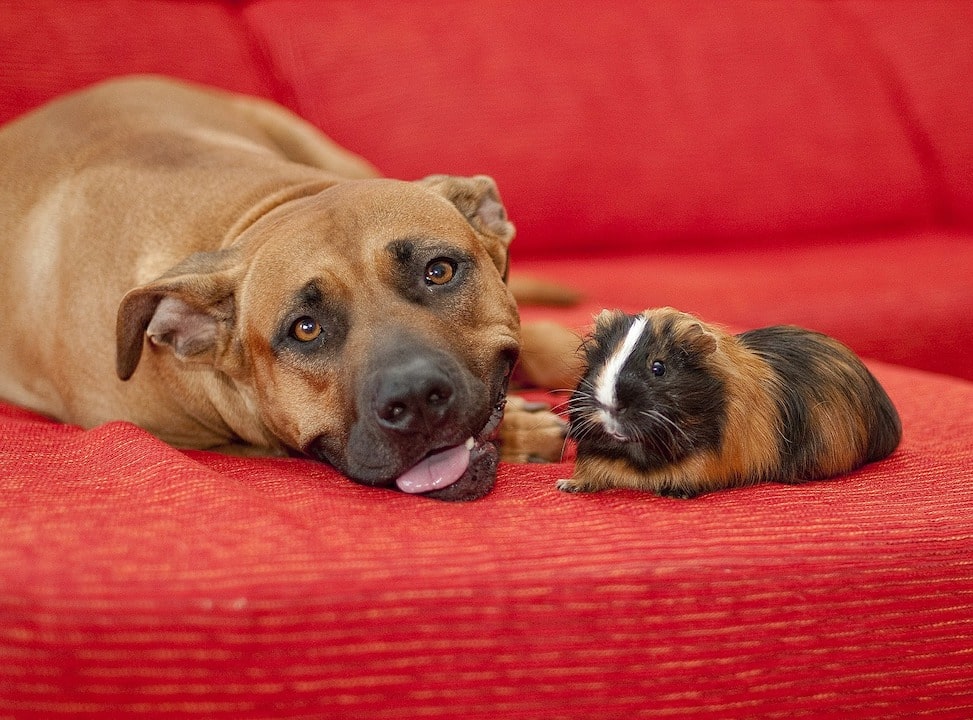If you’re a dog owner, you probably have no doubt that dogs have emotions.
You can tell when your pup is happy or when he’s scared. And, sometimes, it even seems like your four-legged friend can pick up on your emotions, too.
While dogs can feel emotion, they can’t feel the range of emotions that humans do. And, even if you recognize certain emotions, they could actually be a different feeling. For example, the look of shame your dog gives you after he’s pooped in the house is actually a look of fear—because researchers don’t think canines can feel guilt or shame.
While humans have always felt a special connection to their pets, until relatively recently, the evidence was largely anecdotal (personal experiences). However, research now backs up the fact that dogs can feel. With that being said, they’re not capable of complex emotions. Researchers liken their emotional range to that of a two year old child.
Here’s the emotions dogs can actually experience.
#1 Anticipation of Enjoyment—For you and of course, food.
Researchers did MRI scans on willing dogs to observe their caudate nucleus, the part of the brain associated with the anticipation of enjoyment.
The region lit up when:
- They smelled a familiar person
- Their owner entered the room (they love you!)
- Hand signals about food
The researcher notes that this doesn’t necessarily prove hat dogs can feel love, but it does add to the argument that dogs, like humans, experience attachment. Interested in learning more? Researcher Gregory Berns wrote an entire piece for the New York Times about his findings.
#2 Emotional Intuition via Voice and Facial Expressions
Similar to humans, dogs can recognize people’s voices and were sensitive to their emotional tones. One researcher explained that dogs use “acoustic parameters” to sort out a laugh from a cry or whine.
In the experiment, dogs happily lied in an MRI scanner and listened to human voices, dog noses and other environmental noises. As you may expect, their brains lit up most to dog barks or growling.
Next time you cry and your dog comes to your rescue—now you know why!
#3 Empathy
You probably know this one if your dog has ever stood by you while you’re upset or licked the tears from your face.
One study observed dogs as humans spoke, hummed and pretended to cry. You can probably guess the result. Pups didn’t really care when humans spoke normally. Some cared when they hummed. However, most of the canines went up to or touched the person if they pretended to cry.
So this establishes that dogs know the difference between crying and talking, but where does empathy come in? It turns out that the dogs approached the humans in a more submissive way, signaling empathy.
#4 Stress
If you have an anxious dog, you know that pups can get stressed out too.
Many dogs who come from puppy mills or bad homes show signs of stress for even mundane things, like meeting a stranger or going for walks. Other dogs develop separation anxiety, meaning they get stressed out when their owner leaves them at home alone. This can lead to destructive behaviors.
A study looked at how dogs responded to photos of facial reactions. Photos with facial expressions of anger, fear and happiness made the dogs’ heartrate increase and it took them longer to resume eating. This was interpreted as a sign of stress. But why would a happy expression make them stressed? Researchers theorized that open smiles containing barred teeth may have triggered the canines’ instincts.
#5 Fear
Dog shaming photos are hilarious to see on the internet. Despite their popularity, dogs cant feel shame according to science.
If a dog looks guilty after tearing up your favorite pair of shoes or pooping inside, he’s likely responding to your body language. Researchers insist that shame is a more complex emotion that dogs aren’t capable of.
#6 Jealousy
You probably don’t need a study to tell you this one, either. If your dog smells another pup on you, he feels cheated on and may ignore you until he calms down.
Science can back up this anecdotal evidence. Researchers asked dogs to shake a paw, but only some got rewarded with treats. The dogs that didn’t get the prize stopped obeying over half of the commands. They also started showing signs of stress, such as licking.
As you probably know, if another dog gets a treat and your fur baby doesn’t—well, he’s not happy to say the least.
#7 Depression
Unfortunately, depression is an emotion that dogs can feel. While we can’t really tell how dogs feel or if they experience it the same way as humans, typical signs of depression can be present.
Vets say it’s rare for a dog to suffer from long-term depression. However, periods of change can really set a dog off. This can include:
- A recent move
- Bringing home a baby
- Getting another pet
- Change in family schedule
We can’t ask dogs how they feel, but we can assume by certain signs:
- Becoming withdrawn
- Changes in eating habits
- Changes in sleeping habits
- Don’t like to play
However, since these signs can also point to a variety of other conditions, you should get your dog checked out by a vet if he’s experiencing them.
Summary
Dogs can’t feel every emotion humans can. However, research confirms they can experience a certain range of non-complex feelings. They can anticipate enjoyment, have empathy and exercise intuition. Unfortunately, they can also feel “negative” emotions, such as fear, depression, stress and jealousy.

